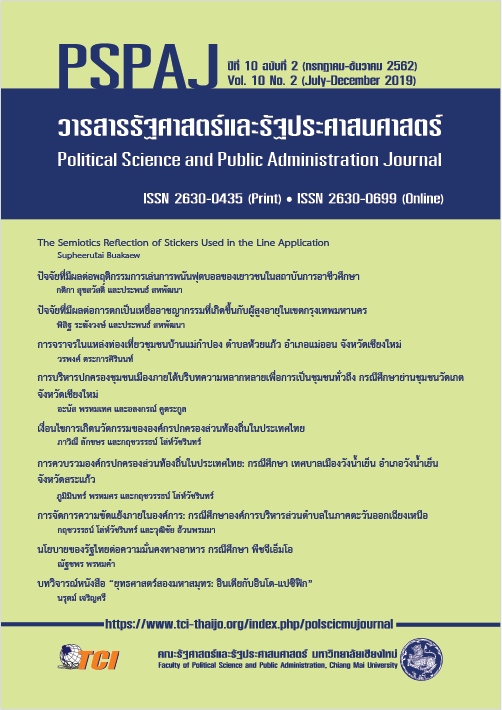การบริหารปกครองชุมชนเมืองภายใต้บริบทความหลากหลายเพื่อการเป็นชุมชนทั่วถึง กรณีศึกษาย่านชุมชนวัดเกต จังหวัดเชียงใหม่
Main Article Content
บทคัดย่อ
การศึกษาครั้งนี้มีวัตถุประสงค์ (1) เพื่อศึกษาพัฒนาการความเป็นชุมชนทั่วถึงของย่านชุมชนวัดเกต (2) เพื่อศึกษาบทบาทภาครัฐ ภาคเอกชน และภาคประชาสังคมในการบริหารปกครองชุมชนเมืองย่านวัดเกตให้เป็นชุมชนทั่วถึง (3) เพื่อวิเคราะห์ปัจจัยที่ส่งผลต่อการเสริมสร้างคุณลักษณะความเป็นชุมชนทั่วถึงของย่านชุมชนวัดเกต จังหวัดเชียงใหม่ โดยใช้การวิจัยเชิงคุณภาพ เก็บรวบรวมข้อมูลด้วยวิธีการสัมภาษณ์แบบกึ่งโครงสร้างและการสนทนากลุ่ม มีจำนวนผู้ให้ข้อมูลทั้งหมด 45 คน ประกอบด้วย 3 ภาคส่วน ได้แก่ ภาครัฐ ภาคเอกชน และภาคประชาสังคมที่มีบทบาทในการบริหารปกครองพื้นที่ย่านชุมชนวัดเกต รวมถึงใช้วิธีการสังเกตการณ์แบบไม่มีส่วนร่วม ตลอดจนการค้นคว้าข้อมูลจากเอกสารงานวิชาการที่เกี่ยวข้อง ผลการศึกษาพบว่า (1) ความเป็นชุมชนทั่วถึงของย่านชุมชนวัดเกตมีการเปลี่ยนแปลงตลอดระยะเวลาในช่วงปี พ.ศ. 2549-2561 (2) ภาคประชาสังคมและภาคเอกชนเป็นผู้มีบทบาทหลักในการบริหารปกครองพื้นที่ ในขณะที่ภาครัฐมีบทบาทเป็นผู้อำนวยความสะดวก และ (3) ปัจจัยที่ส่งผลต่อการเสริมสร้างคุณลักษณะความเป็นชุมชนทั่วถึงของย่านชุมชนวัดเกต จังหวัดเชียงใหม่ ประกอบด้วย
3 ปัจจัยตามหลักแนวคิด ได้แก่ ปัจจัยด้านเศรษฐกิจ ปัจจัยด้านสังคม และปัจจัยด้านพื้นที่ นอกจากนี้ ผู้วิจัยยังพบว่ามีปัจจัยที่สำคัญอีกประการหนึ่ง คือ ปัจจัยด้านการบริหารปกครอง อันมีรายละเอียดนอกเหนือจากบทบาทของแต่ละภาคส่วน
Article Details
- เนื้อหาและข้อมูลที่ลงตีพิมพ์ในวารสารรัฐศาสตร์และรัฐประศาสนศาสตร์ถือเป็นข้อคิดเห็นและความรับผิดชอบของผู้เขียนบทความโดยตรง ซึ่งกองบรรณาธิการวารสารรัฐศาสตร์และรัฐประศาสนศาสตร์ ไม่จำเป็นต้องเห็นด้วย หรือร่วมรับผิดชอบใดๆ
- บทความและข้อมูล ที่ได้รับการตีพิมพ์ในวารสารรัฐศาสตร์และรัฐประศาสนศาสตร์ ถือเป็นลิขสิทธิ์ของวารสาร หากบุคคลหรือหน่วยงานใดต้องการนำข้อมูลไปใช้ประโยชน์ในทางวิชาการ ขอให้อ้างอิงแหล่งที่มาด้วย
เอกสารอ้างอิง
ดวงจันทร์ อาภาวัชรุตม์ เจริญเมือง. (2549). เมืองเชียงใหม่ที่ยั่งยืน: แนวคิดและประสบการณ์ของย่านวัดเกต เชียงใหม่. เชียงใหม่: สถาบันวิจัยสังคม มหาวิทยาลัยเชียงใหม่.
Avis, W. R. (2016). Urban Governance (Topic Guide). Birmingham, UK: GSDRC, University of Birmingham.
Broadhead, J. (2017). Inclusive Cities: Inclusive Practices for Newcomers at City Level and Examples of Innovation from Overseas. Oxford: The Global Exchange on Migration and Diversity.
Lange, F. E. (2010). Urban Governance. An Essential Determinant of City Development. Bonn: World Vision Institute for Research and Development.
Taran, P., De Lima, G. N., & Kadysheva, O. (2016). Cities Welcoming Refugees and Migrants: Enhancing Effective Urban Governance in an Age of Migration. United Nations Educational, Scientific and Cultural Organization (UNESCO).
UN-HABITAT. (n.d.). An Inclusive City. Retrieved September 28, 2017, from https://mirror.unhabitat.org/categories.asp?catid=691
United Nations. (2014). Growth Rates of Urban Agglomerations by Size Class. Retrieved September 28, 2017, from https://esa.un.org/unpd/wup/Maps/CityGrowth/CityGrowth.aspx
World Bank. (2015). Inclusive Cities. Retrieved September 28, 2017, from https://www.worldbank.org/en/topic/urbandevelopment/brief/inclusive-cities


